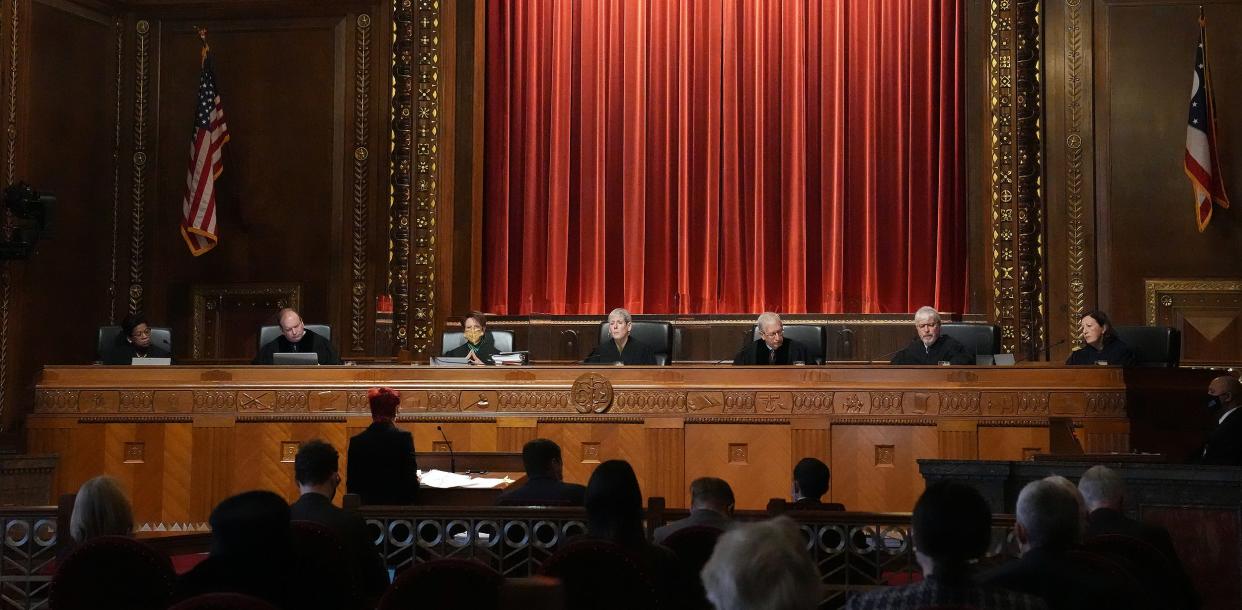Ohio Supreme Court rejects legislative maps for 5th time, but feds might use them anyway

- Oops!Something went wrong.Please try again later.
The Ohio Supreme Court once again rejected state House and Senate maps that favor Republicans, but a federal court is poised to impose them anyway.
The 4-3 decision released Wednesday afternoon stated that the fifth set of maps were unconstitutional and nearly identical to the third set, which the court previously rejected. The court ordered a new, sixth set be submitted by June 3.
But that order might not have any bearing on how the districts look for the 2022 elections.
A trio of federal judges has made clear they will impose that third set of maps if the Ohio Redistricting Commission doesn't approve a better alternative by May 28.
The idea was to put an end to the tug of war between those drawing districts for the Ohio Legislature and the Ohio Supreme Court, which is tasked with interpreting anti-gerrymandering language in the state Constitution.
"We must presume that Ohio’s officials are public servants who still view partisan advantage as subordinate to the rule of law," wrote Judges Amul Thapar and Benjamin Beaton.
But that's not what happened, according to the concurring opinion written by Ohio Chief Justice Maureen O'Connor.
Citing reporting from the USA Today Ohio Network about Senate President Matt Huffman, O'Connor wrote the Republican majority on the commission did what they wanted.
O'Connor says Republicans 'ignoring rulings'
And that "do what we want apparently translates into the Republican-majority members of the redistricting commission ignoring rulings of this state’s highest court and the mandates of Ohio’s Constitution," she wrote.
More: Who's Matt Huffman? The Lima man running the show at the Ohio Statehouse
Justice Michael Donnelly, a Democrat, agreed that the federal court's decision, announced April 20, effectively eliminated any incentive for the gridlocked Ohio Redistricting Commission to pick a different set of maps. Add to that Ohio Secretary of State Frank LaRose's concerns about running an Aug. 2 primary election with new maps, and the will to craft new districts dwindled.
Republican legislative leaders even sent proxies to vote on the legislative maps, saying they needed to work on Ohio's capital budget instead.
So, four Republicans on the commission submitted the Feb. 24 maps to the Ohio Supreme Court for the second time, knowing the state court would reject that plan but hoping the federal court would still accept it.
Chief Justice says voters need to change system
O'Connor urged Ohio voters to push through another redistricting reform.
"Having witnessed the ways in which constitutional reforms may be frustrated by hyper-partisanship and the power of inertia, Ohioans have the power to change those dynamics," O'Connor wrote. "That opportunity must not be squandered."
The Ohio Supreme Court decided not to penalize the commission for effectively ignoring its orders to draw new maps. The four justices in the majority had previously called and then canceled a hearing on whether the commission members should be held in contempt.
A move that the three Republican justices in the minority strongly disagreed with.
Justice Sharon Kennedy, a Republican running for chief justice this year, said in her dissent that the four-justice majority “hijacked” the redistricting process and ignored the court’s constitutional role. She wrote that the majority was wrong to reject the map the first time and again on Wednesday.
“The people of Ohio need look no further than this court for the sole cause of the debacle of the missing primary,” Kennedy said in her opinion, which was joined by Justice Pat DeWine, a Republican and son of Gov. Mike DeWine, who serves on the redistricting commission.
Justice Pat Fischer, a Republican, issued a separate dissent, noting that “Ohioans will in all likelihood be voting for state representatives in a special election imposed on this state by a panel of federal judges.”
What's next?
Federal judges promised to step in by Saturday and set an Aug. 2 primary for state House and Senate seats. If that court imposes maps, they will apply only to the 2022 elections.
That means mapmakers will still need a solution for 2024 and beyond. Advocates of redistricting reform are mulling their options, which include placing a new constitutional amendment on the ballot.
Another factor is the balance of the Ohio Supreme Court, which will be different after O'Connor leaves the court Dec. 31. The deciding vote in the 4-3 redistricting decisions must retire because of age limits on judges.
Jessie Balmert is a reporter for the USA TODAY Network Ohio Bureau, which serves the Akron Beacon Journal, Cincinnati Enquirer, Columbus Dispatch and 18 other affiliated news organizations across Ohio.
Get more political analysis by listening to the Ohio Politics Explained podcast
8505809002
- Embed
- Not set
- Not set
- Not set
- 10/18/21 9:32:54 AM
- Not embargoed
embed:
Return to Asset Tab
No caption
No credit
SEO Warning
Layout Priority
This article originally appeared on Cincinnati Enquirer: Ohio redistricting: Supreme Court rejects maps, but feds might use them

